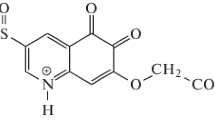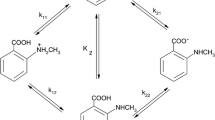Summary
The partition constants, minimal solubilities and dissociation equilibrium constants of 8-hydroxyquinoline and 5-chloro-8-hydroxy-quinoline and the partition constant of 5-nitro-8-hydroxyquinoline have been determined for the system n-octanol—aqueous buffer solution at 25° C and 0.01M ionic strength. The effect of substituent and organic solvent on these parameters have been discussed. The thermodynamic dissociation constants, obtained from spectrophotometric measurements, are: 8-hydroxyquinoline,pK 1= 4.94 ± 0.01,pK 2= 9.82 ± 0.01; 5-chloro-8-hydroxyquinoline,pK 1 = 3.79 ± 0.01,pK 2 = 9.29 ± 0.01.
Zusammenfassung
Die Verteilungskoeffizienten, die Löslichkeiten beim isoelektrischen Punkt und die Dissoziationskonstanten von 8-Hydroxychinolin(I) und 5-Chlor-8-hydroxychinolin(II) sowie der Verteilungskoeffizient von 5-Nitro-8-hydroxychinolin wurden für das Systemn-Oktanol-wäßrige Pufferlösung bei 25° C und Ionenstärke 0,01-m bestimmt. Der Einfluß der Substituenten und des organischen Lösungsmittels auf die erwähnten Parameter wurden diskutiert. Die thermodynamischen Dissoziationskonstanten, die sich aus spektrophotometrischen Messungen ergaben, sind folgende: I: pK1 = 4,94± 0,01, pK2 = 9,82 ±0,01; II: pK1 = 3,79 ±0,01, pK2 = 9,29 ±0,01.
Similar content being viewed by others
References
C. Klofutar, Š. Paljk, F. Krašovec, and I. Horvat, Mikrochim. Acta [Wien]1973, 559.
C. Hansch in: E. J. Ariëns, Ed., Drug Design, New York: Academic Press. 1971. p. 271.
A. F. Sukhina, Zh. Obshch. Khim.32, 1356 (1962).
V. Petrov and B. Sturgeon, J. Chem. Soc.1954, 570.
A. E. Martell and M. Calvin, Chemistry of the Metal Chelate Compounds, Englewood Cliffs: Prentice-Hall. 1956. p. 501.
J. A. Riddick and W. B. Bunger, Organic Solvents; Physical Properties and Methods of Purification, in: A. Weissberger, Ed., Techniques of Chemistry, New York: Wiley. 1970. p. 181.
A. L. Beilby, Ed., Modern Classics in Analytical Chemistry, Washington: Amer. Chem. Soc. 1970. p.7.
Yu. A. Zolotov, Extraction of Chelate Compounds, London: ArborHumphrey. 1970. p. 38.
H. Irving, J. A. D. Evart, and J. T. Wilson, J. Chem. Soc.1949, 2672.
C. Hansch, J. E. Quinlan, and G. L. Lawrence, J. Org. Chem.33, 347 (1968).
R. Näsänen, P. Lumme, and A. L. Mukula, Acta Chem. Scand.5, 1199 (1951).
A. Albert and E. P. Serjeant, The Determination of Ionization Constants, Edinburgh: Constable. 1971. p. 6.
E. J. King, Acid-Base Equilibria, Vol. 4, in: E. A. Guggenheim, J. E. Mayer, and F. C. Tompkins, Eds., The International Encyclopedia of Physical Chemistry and Chemical Physics, New York: MacMillan. 1965. p. 118, 137.
J. W. Larson and L. G. Hepler in: J. F. Coetzee and C. D. Ritchie, Solute — Solvent Interactions, New York: Dekker. 1969. p. 1.
Author information
Authors and Affiliations
Rights and permissions
About this article
Cite this article
Paljk, Š., Klofutar, C., Krašovec, F. et al. Dissociation of 8-hydroxyquinoline and its 5-chloro- and 5-nitro-derivatives in aqueous solutions. Mikrochim Acta 64, 485–492 (1975). https://doi.org/10.1007/BF01219217
Received:
Issue Date:
DOI: https://doi.org/10.1007/BF01219217




